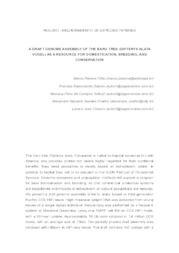A draft genome assembly of the baru tree (Dipteryx alata vogel) as a resource for domestication, breeding and conservation.
A draft genome assembly of the baru tree (Dipteryx alata vogel) as a resource for domestication, breeding and conservation.
Author(s): PESSOA FILHO, M. A. C. de P.; SOARES, T. N.; TELLES, M. P. de C.; COELHO, A. S. G.; CHAVES, L. J.
Summary: Baru seed production is mostly based on extractivism, which, in addition to habitat loss, led to its inclusion in the IUCN Red List of Threatened Species. Genomic resources and propagation methods will support a program for baru domestication and breeding, so that commercial production systems are established and impacts of extractivism on natural populations are reduced. We present a draft genome assembly of the D. alata, based on third-generation PacBio CCS HiFi reads. High molecular weight DNA was extracted from young leaves of a single diploid individual. Sequencing was performed on a Sequel II system at Maryland Genomics, using one SMRT cell 8M on CCS HiFi mode, with a 30-hour runtime. Approximately 16 Gb were obtained in 1,4 million CCS reads, with an average size of 11kbp. The partially phased draft assembly was obtained with Hifiasm in HiFi-only mode.
Publication year: 2023
Types of publication: Abstract in annals or event proceedings
Unit: Embrapa Cerrados
Keywords: Baru, Cerrado, Dipteryx Alata
Observation
Some of Embrapa's publications are published as ePub files. To read them, use or download one of the following free software options to your computer or mobile device. Android: Google Play Books; IOS: iBooks; Windows and Linux: Calibre.
Access other publications
Access the Agricultural Research Database (BDPA) to consult Embrapa's full library collection and records.
Visit Embrapa Bookstore to purchase books and other publications sold by Embrapa.

